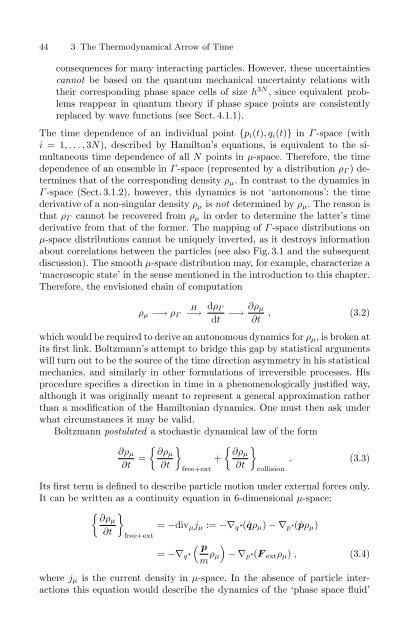The Physical Basis of The Direction of Time (The Frontiers ...
The Physical Basis of The Direction of Time (The Frontiers ...
The Physical Basis of The Direction of Time (The Frontiers ...
Create successful ePaper yourself
Turn your PDF publications into a flip-book with our unique Google optimized e-Paper software.
44 3 <strong>The</strong> <strong>The</strong>rmodynamical Arrow <strong>of</strong> <strong>Time</strong><br />
consequences for many interacting particles. However, these uncertainties<br />
cannot be based on the quantum mechanical uncertainty relations with<br />
their corresponding phase space cells <strong>of</strong> size h 3N , since equivalent problems<br />
reappear in quantum theory if phase space points are consistently<br />
replaced by wave functions (see Sect. 4.1.1).<br />
<strong>The</strong> time dependence <strong>of</strong> an individual point {p i (t),q i (t)} in Γ -space (with<br />
i =1,...,3N), described by Hamilton’s equations, is equivalent to the simultaneous<br />
time dependence <strong>of</strong> all N points in µ-space. <strong>The</strong>refore, the time<br />
dependence <strong>of</strong> an ensemble in Γ -space (represented by a distribution ρ Γ )determines<br />
that <strong>of</strong> the corresponding density ρ µ . In contrast to the dynamics in<br />
Γ -space (Sect. 3.1.2), however, this dynamics is not ‘autonomous’: the time<br />
derivative <strong>of</strong> a non-singular density ρ µ is not determined by ρ µ . <strong>The</strong> reason is<br />
that ρ Γ cannot be recovered from ρ µ in order to determine the latter’s time<br />
derivative from that <strong>of</strong> the former. <strong>The</strong> mapping <strong>of</strong> Γ -space distributions on<br />
µ-space distributions cannot be uniquely inverted, as it destroys information<br />
about correlations between the particles (see also Fig. 3.1 and the subsequent<br />
discussion). <strong>The</strong> smooth µ-space distribution may, for example, characterize a<br />
‘macroscopic state’ in the sense mentioned in the introduction to this chapter.<br />
<strong>The</strong>refore, the envisioned chain <strong>of</strong> computation<br />
ρ µ −→ ρ Γ<br />
H<br />
−→<br />
dρ Γ<br />
dt<br />
−→ ∂ρ µ<br />
∂t<br />
, (3.2)<br />
which would be required to derive an autonomous dynamics for ρ µ ,isbrokenat<br />
its first link. Boltzmann’s attempt to bridge this gap by statistical arguments<br />
will turn out to be the source <strong>of</strong> the time direction asymmetry in his statistical<br />
mechanics, and similarly in other formulations <strong>of</strong> irreversible processes. His<br />
procedure specifies a direction in time in a phenomenologically justified way,<br />
although it was originally meant to represent a general approximation rather<br />
than a modification <strong>of</strong> the Hamiltonian dynamics. One must then ask under<br />
what circumstances it may be valid.<br />
Boltzmann postulated a stochastic dynamical law <strong>of</strong> the form<br />
∂ρ µ<br />
∂t<br />
=<br />
{ ∂ρµ<br />
∂t<br />
}<br />
free+ext<br />
+<br />
{ ∂ρµ<br />
∂t<br />
}<br />
collision<br />
. (3.3)<br />
Its first term is defined to describe particle motion under external forces only.<br />
It can be written as a continuity equation in 6-dimensional µ-space:<br />
{ } ∂ρµ<br />
= −div µ j µ := −∇ q·( ˙qρ µ ) −∇ p·(ṗρ µ )<br />
∂t<br />
free+ext<br />
( p<br />
)<br />
= −∇ q·<br />
m ρ µ −∇ p·(F ext ρ µ ) , (3.4)<br />
where j µ is the current density in µ-space. In the absence <strong>of</strong> particle interactions<br />
this equation would describe the dynamics <strong>of</strong> the ‘phase space fluid’



![arXiv:1001.0993v1 [hep-ph] 6 Jan 2010](https://img.yumpu.com/51282177/1/190x245/arxiv10010993v1-hep-ph-6-jan-2010.jpg?quality=85)


![arXiv:1008.3907v2 [astro-ph.CO] 1 Nov 2011](https://img.yumpu.com/48909562/1/190x245/arxiv10083907v2-astro-phco-1-nov-2011.jpg?quality=85)








![arXiv:1002.4928v1 [gr-qc] 26 Feb 2010](https://img.yumpu.com/41209516/1/190x245/arxiv10024928v1-gr-qc-26-feb-2010.jpg?quality=85)
![arXiv:1206.2653v1 [astro-ph.CO] 12 Jun 2012](https://img.yumpu.com/39510078/1/190x245/arxiv12062653v1-astro-phco-12-jun-2012.jpg?quality=85)
